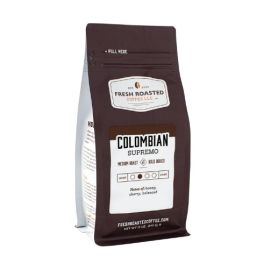
Dark roast coffee, as the name suggests, involves roasting coffee beans to a darker level compared to lighter or medium roasts. This process imparts a characteristic deep, rich color to the beans and typically produces coffee with bold, robust flavors. Common flavor notes include chocolate, caramel, and sometimes a smoky or burnt taste, which comes from the longer roasting time.
Dark roast coffees are often described as strong and full-bodied. The oils on the beans, which become more pronounced during the roasting process, contribute to the coffee’s glossy appearance. This type of roast tends to have less caffeine than its lighter counterparts, contrary to popular belief, because caffeine diminishes with increased roasting.
The term “acidity” in coffee denotes the sharp, bright taste that can be akin to flavors found in fruits and is actually a desired quality in many coffee varieties. However, acidity in coffee doesn’t refer to the pH level alone but also to the flavor notes that emerge due to organic acids like chlorogenic acid, which breaks down during roasting. In dark roast coffee, much of this acidity is muted, resulting in a smoother cup that may lack some of the complexity of lighter roasts.
Key Takeaways on Dark Roast Coffee Acidity
- Less Acidity: The longer roasting process of dark roasts reduces the acidity significantly. This is because the heat breaks down more of the chlorogenic acids present in the beans, which are responsible for producing sharp, tangy flavors in lighter roasts.
- Smoother Taste: As a result of this reduced acidity, dark roast coffee typically has a smoother, richer flavor. This makes it an excellent choice for those who prefer their coffee less tangy or sharp. However, this smoothness can sometimes mask other subtle flavors that coffee aficionados might appreciate.
- Robust Flavor Profile: Despite the loss of some flavor complexity, dark roasts are appreciated for their bold and straightforward flavor profiles. Notes of chocolate, caramel, and even smokiness make dark roast coffee a favored choice for a hearty, warming cup.
Chemical Changes During Roasting
Roasting coffee is essentially a heat-induced transformation of green coffee beans into the aromatic brown beans we use for brewing. During this process, several chemical reactions occur, notably the Maillard reaction and caramelization, which significantly alter the flavor and chemical properties of the beans.
The Maillard reaction, where sugars and amino acids combine under heat, contributes to flavor complexity and dark colors. Caramelization, the browning of sugar, enhances sweetness and richness.
Impact on Acidity
As the beans are exposed to heat, organic acids break down. Chlorogenic acids, dominant in green beans, degrade into quinic and caffeic acids. These transformations lead to a reduction in perceived acidity, particularly noticeable in dark roasts. The longer the beans are roasted, the more these acids decompose, which mutes the bright, tangy notes prominent in lighter roasts and results in the smoother, deeper tones of dark roast coffee.
Roasting Techniques and Acidity
Different roasting techniques can influence the acidity levels in coffee. For instance, a quick, high-temperature roast might retain more acidic qualities by preserving some of the chlorogenic acids compared to a slow, extended roast which allows more time for these acids to break down.
Specific Roasting Methods
- Light Roast: Typically stopped at the first crack, retains most of the original acidity, resulting in a brighter cup.
- Medium Roast: Goes a bit beyond the first crack, reducing some acidity but maintaining balance.
- Dark Roast: Extends to the second crack or beyond, significantly reducing acidity and bringing forward a bolder, smoother profile.
Brewing Methods and Their Impact on Acidity
Espresso
The espresso brewing method involves forcing hot water through finely-ground coffee at high pressure. This quick extraction process tends to emphasize the natural acidity in coffee. However, with dark roasts, the inherent lower acidity means that even an espresso will have a smoother, less tart flavor compared to using lighter roasts.
French Press
The French press, or plunger pot, allows coffee grounds to steep directly in hot water for several minutes before the mesh filter is pressed down to separate the grounds from the liquid. This method extracts more oils and a fuller flavor profile, including the subtle acids that contribute to the coffee’s overall taste.
For dark roasts, the result is a rich, full-bodied cup with less perceived acidity than lighter roasts brewed in the same way.
Cold Brew
Cold brew coffee is made by steeping coarse-ground beans in cold water for 12 to 24 hours. This method results in significantly lower acidity, making it ideal for dark roasts, as it enhances their smooth and chocolaty characteristics without any sharpness. The lack of heat in the brewing process means fewer acids are extracted, creating a milder, smoother cup that’s easier on the stomach.
Benefits of Lower Acidity
Coffee’s acidity can sometimes lead to digestive discomfort for some people, particularly those with conditions like gastroesophageal reflux disease (GERD) or sensitive stomachs. Dark roast coffee, known for its lower acidity, can be more suitable for these individuals.
Advantages for GERD Patients
For those with GERD, lower acidity in coffee may reduce the likelihood of acid reflux symptoms, which are often triggered by higher acidity foods and drinks. By choosing dark roast coffees, which naturally have less chlorogenic acid, the risk and severity of reflux can decrease, making it a more comfortable coffee option for daily consumption.
Balancing Taste and Health
For those who love the robust flavor of dark roast coffee but are sensitive to acidity, balancing taste with digestive comfort is key. Here are a few tips:
- Choose Low-Acid Dark Roasts: Opt for dark roasts specifically labeled as low-acid to minimize digestive discomfort.
- Modify Brewing Methods: Try cold brewing your dark roast to reduce acidity further, which can be gentler on your stomach.
- Adjust Grind Size: Use a coarser grind to reduce the surface area exposed to water, which can help lower acid extraction during brewing.
FAQs
What are the differences in acidity between dark and light roasts?
Light roasts tend to retain more of their original acidity because the beans are roasted for a shorter period. In contrast, dark roasts have a longer roasting time which breaks down more of the acidic compounds, resulting in a smoother taste.
How can I reduce coffee acidity at home?
You can opt for a cold brew method, add a pinch of salt to the grounds before brewing to neutralize some of the acidity, or choose a darker roast. Using water with a higher mineral content can also help balance the coffee’s acidity.
What are the best dark roasts for low acidity?
Look for beans labeled as low-acid, from regions known for naturally lower-acid beans such as Brazil or Sumatra. Roasts described as smooth, mellow, or balanced are often lower in acidity.
Final Thoughts
Dark roast coffee, with its bold and rich flavors, typically features lower acidity compared to lighter roasts. This makes it a preferable choice for coffee lovers who are sensitive to acidic foods and beverages. Throughout our discussion, we’ve explored how the roasting process reduces acidity, different brewing methods to manage acidity further, and ways to balance coffee enjoyment with health considerations.









